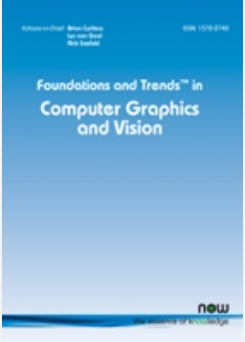几何计算机视觉中使用的相机模型和基本概念
IF 9.3
Q2 COMPUTER SCIENCE, INTERDISCIPLINARY APPLICATIONS
引用次数: 231
摘要
这项调查的主要动机是增加可用性和使用全景图像采集设备,在计算机视觉和它的各种应用。存在不同的技术和不同的计算模型,几何计算机视觉(“结构-运动”)的算法和理论研究经常被重新开发,而没有突出共同的基本原理。本调查的目标之一是概述计算机视觉中使用的图像采集方法,特别是多年来提出和研究的大量相机模型,我们试图指出不同模型之间的相似性。综述了不同相机模型的极极和多视点几何以及各种校准和自校准方法的研究结果,重点介绍了非透视相机。我们最后描述了我们认为是几何计算机视觉或运动结构的基本构建块:极几何,姿态和运动估计,3D场景建模和束调整。这里的主要目标是强调这些的主要原则,这些原则独立于特定的相机模型。本文章由计算机程序翻译,如有差异,请以英文原文为准。
Camera Models and Fundamental Concepts Used in Geometric Computer Vision
This survey is mainly motivated by the increased availability and use of panoramic image acquisition devices, in computer vision and various of its applications. Different technologies and different computational models thereof exist and algorithms and theoretical studies for geometric computer vision ("structure-from-motion") are often re-developed without highlighting common underlying principles. One of the goals of this survey is to give an overview of image acquisition methods used in computer vision and especially, of the vast number of camera models that have been proposed and investigated over the years, where we try to point out similarities between different models. Results on epipolar and multi-view geometry for different camera models are reviewed as well as various calibration and self-calibration approaches, with an emphasis on non-perspective cameras. We finally describe what we consider are fundamental building blocks for geometric computer vision or structure-from-motion: epipolar geometry, pose and motion estimation, 3D scene modeling, and bundle adjustment. The main goal here is to highlight the main principles of these, which are independent of specific camera models.
求助全文
通过发布文献求助,成功后即可免费获取论文全文。
去求助
来源期刊

Foundations and Trends in Computer Graphics and Vision
COMPUTER SCIENCE, INTERDISCIPLINARY APPLICATIONS-
CiteScore
31.20
自引率
0.00%
发文量
1
期刊介绍:
The growth in all aspects of research in the last decade has led to a multitude of new publications and an exponential increase in published research. Finding a way through the excellent existing literature and keeping up to date has become a major time-consuming problem. Electronic publishing has given researchers instant access to more articles than ever before. But which articles are the essential ones that should be read to understand and keep abreast with developments of any topic? To address this problem Foundations and Trends® in Computer Graphics and Vision publishes high-quality survey and tutorial monographs of the field.
Each issue of Foundations and Trends® in Computer Graphics and Vision comprises a 50-100 page monograph written by research leaders in the field. Monographs that give tutorial coverage of subjects, research retrospectives as well as survey papers that offer state-of-the-art reviews fall within the scope of the journal.
 求助内容:
求助内容: 应助结果提醒方式:
应助结果提醒方式:


